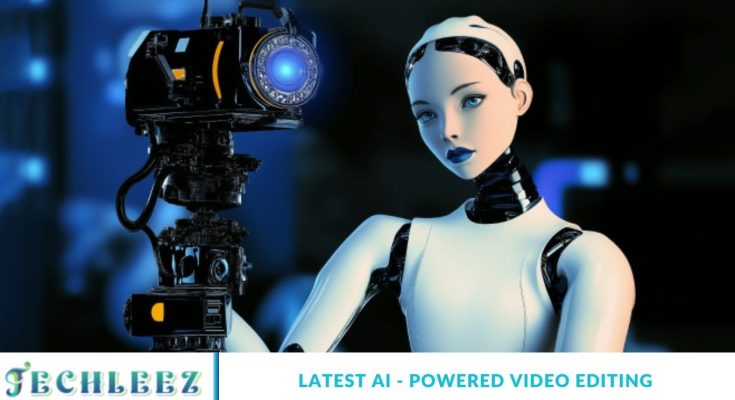The landscape of video editing has undergone a dramatic transformation with the emergence of AI-powered tools. What was once a time-intensive and complex task is now faster, wiser, and more accessible thanks to advancements in artificial intelligence. At the forefront of this transformation is a breakthrough technology known as AI Video Editing. This innovative approach is set to redefine how we create and edit videos by automating and enhancing various editing processes. In this article, we’ll explore what AI Video Editing is, how it functions, its key features, advantages and disadvantages, and popular alternatives, and we’ll wrap up with a conclusion and FAQs to give you a complete overview of this game-changing technology.
What is New AI Video Editing?
New AI Video Editing is an advanced approach to video production that utilizes artificial intelligence (AI) and machine learning algorithms to streamline and automate the editing process. Unlike traditional video editing software, which demands manual precision and time-consuming tasks, AI-powered video editing tools can perform complex functions—such as cutting, trimming, splicing, color correction, effects enhancement, and even content generation—with minimal human input.
This innovative technology is designed to cater to a diverse audience, including professional video editors, content creators, social media influencers, and beginners seeking intuitive, high-quality video editing solutions. By analyzing video content and recognizing patterns, AI video editing software can make intelligent decisions that align with the user’s creative goals—often completing tasks in seconds that would take a human editor hours.
One of the most transformative features of AI video editing tools is their ability to learn and improve over time. As these systems process more data, they become increasingly accurate and efficient, offering more brilliant suggestions and automated edits based on user preferences and content trends. From auto-selecting the best clips to applying visually appealing filters and even generating fully edited videos from raw footage, AI video editing technology is revolutionizing how videos are created, edited, and shared.
How New AI Video Editing Works
To fully understand how New AI Video Editing works, it’s essential to explore the core technologies and processes that drive this cutting-edge innovation. Powered by advanced artificial intelligence, machine learning models, and computer vision, AI video editing tools follow a streamlined, intelligent workflow designed to automate and enhance the video production process. Here’s a breakdown of the typical steps involved.
Data Input and Smart Content Analysis
- Input Sources: The process begins with the upload of raw video content, which may come from various sources such as smartphones, digital cameras, screen recordings, or existing video files. AI video editors support a wide range of formats and resolutions, ensuring seamless compatibility across diverse media types.
- Content Analysis: Once the video is uploaded, the AI performs deep content analysis using computer vision and natural language processing. It can detect faces, objects, actions, emotions, and spoken words. For example, the AI can identify when someone is talking, when a scene shifts, or when a specific gesture or event takes place—laying the groundwork for intelligent editing decisions.
Scene Detection and Intelligent Segmentation
- Scene Recognition: Advanced AI algorithms identify scene transitions based on changes in visual elements such as backgrounds, subjects, lighting, and camera angles. This is particularly effective for long-form videos, interviews, vlogs, or documentaries, where multiple scenes require distinct editing.
- Timeline Creation: After segmenting the video, the AI arranges the scenes in a logical sequence, creating a dynamic editing timeline. This structured timeline allows the system to apply contextual edits, transitions, and effects with precision.
Automated Editing and Smart Enhancements
- Cutting and Splicing: Using machine learning, the AI automatically trims the footage by detecting the best moments and removing unnecessary parts such as long pauses, redundant dialogue, or shaky shots. This dramatically accelerates what is typically one of the most time-consuming tasks in video editing.
- Transitions and Visual Effects: AI seamlessly inserts transitions to ensure a smooth narrative flow between scenes. Additionally, it applies color correction, visual filters, stabilization, motion graphics, and other stylistic enhancements based on the content type and desired aesthetic—often learning from previous user preferences or templates.
Audio Optimization and Subtitle Generation
- Voice and Music Detection: AI-powered editing tools can isolate and enhance audio tracks, adjusting levels for voice clarity, background noise reduction, and music balance. The system can even add royalty-free background music that matches the tone, pacing, or emotion of the video.
- Subtitles and Captions: Speech-to-text algorithms generate automatic subtitles and captions with high accuracy. This not only improves content accessibility for deaf viewers but also increases engagement for audiences watching without sound—especially on social media platforms.
Final Rendering and Optimized Exporting
- Rendering: Once all edits are applied, the AI renders the final video with optimized performance. Unlike traditional editing software that may require extended rendering times, AI accelerates this process by using innovative presets tailored to the content and platform.
- Exporting: The finished video can be exported in multiple formats and resolutions, making it ready for YouTube, Instagram, TikTok, LinkedIn, or high-definition presentations. AI ensures each video meets platform-specific requirements—whether it’s vertical for reels or 4K for cinematic projects.
Features of New AI Video Editing [Completely Detailing]
What truly distinguishes New AI Video Editing from traditional editing software is its intelligent, automation-driven feature set. Designed to enhance productivity, creativity, and accessibility, these AI-powered tools offer a range of advanced functionalities that simplify the video editing process. Below, we take a closer look at the standout features that make AI video editing a game-changer for content creators of all levels.
Automated Editing
- Brilliant Scene Selection: AI automatically identifies and selects the best moments from raw footage, allowing editors to focus more on creative refinements rather than manual selections.
- Auto-Cutting and Splicing: The system precisely trims and joins clips, removing unnecessary segments and ensuring smooth, professional transitions.
- Instant Preview: Users can preview edits in real-time, enabling fast tweaks and eliminating the wait typically required for rendering.
AI-Powered Filters and Effects
- Dynamic Filters: AI applies intelligent filters that adapt to video content, enhancing visual quality through optimized color, contrast, and brightness.
- Special Effects: From motion graphics to augmented reality, AI seamlessly integrates special effects tailored to the style and tone of the video.
Intelligent Audio Editing
- Noise Reduction: Background noise is automatically filtered out, improving audio clarity and making voiceovers or dialogue stand out.
- Voice Recognition: AI isolates and enhances voice tracks, adjusting levels to ensure crisp, professional-grade sound.
- Auto-Music Integration: The system selects or inserts music tracks that align with the pacing and mood of the video for enhanced emotional impact.
Content-Aware Editing
- Face and Object Recognition: AI can detect and track faces and key objects, making advanced edits like background blur or focus enhancements effortless.
- Emotion Detection: Using emotional analysis, AI tailors the editing style—such as applying warm filters for happy scenes or muted tones for dramatic moments.
Template-Based Editing
- Pre-Designed Templates: Access a library of professionally designed templates for various content types like social media videos, vlogs, or business presentations.
- Customizable Layouts: Each template is fully editable, giving users control over transitions, effects, and audio to suit their brand or style.
AI-Driven Storyboarding
- Automated Storyboards: AI creates visual storyboards from your footage, providing a clear roadmap of the video’s structure before final edits.
- Scene Suggestions: Based on content relevance and quality, AI recommends which scenes to keep, cut, or reposition to enhance the storytelling.
Collaboration Features
- Cloud Integration: AI tools often support cloud-based workflows, enabling seamless team collaboration and synchronized editing in real-time.
- Version Control: Easily manage project versions with AI-powered tracking that allows for quick rollbacks and history review.
Automated Subtitles and Captions
- Speech-to-Text: AI transcribes spoken content into accurate subtitles, improving accessibility and SEO for video content.
- Multi-Language Support: Generate subtitles in multiple languages instantly, making content globally accessible and more engaging.
Time-Saving Tools
- Batch Processing: AI processes and edits multiple videos simultaneously, drastically reducing turnaround time for large content batches.
- Brilliant Rendering: With optimized settings based on video type and output platform, AI speeds up the rendering process without compromising quality.
Accessibility and User-Friendliness
- Drag-and-Drop Interface: Most AI editors feature beginner-friendly interfaces that simplify complex tasks through drag-and-drop functionality.
- Guided Tutorials: AI-powered tutorials provide step-by-step guidance, helping users master the software quickly and efficiently.
Pros of New AI Video Editing [Use Table]
The following table highlights the pros of New AI Video Editing:
| Pros | Description |
|---|---|
| Time Efficiency | AI automates repetitive tasks, significantly reducing the time needed to edit videos. |
| User-Friendly Interface | Many AI video editors offer intuitive interfaces that cater to both beginners and professionals. |
| High-Quality Output | AI enhances video quality through smart filters, effects, and precise editing techniques. |
| Versatility | Supports a wide range of video formats, resolutions, and editing styles, making it suitable for various types of projects. |
| Accessibility | Offers features like automated subtitles and guided tutorials, making video editing accessible to a broader audience. |
| Real-Time Editing | Instant preview and smart rendering allow users to see changes in real-time, streamlining the editing process. |
| Cloud Collaboration | Integration with cloud services enables real-time collaboration on projects, ideal for team-based work. |
| Advanced Audio Editing | AI-driven tools for noise reduction, voice recognition, and automatic music integration enhance audio quality. |
| Smart Storyboarding | AI-generated storyboards and scene suggestions help in organizing and planning video projects efficiently. |
| Content-Aware Editing | AI can recognize faces, objects, and emotions, allowing for more targeted and context-sensitive edits. |
Cons of New AI Video Editing [Use Table]
While New AI Video Editing offers numerous benefits, it also has its drawbacks. The table below outlines some of the cons:
| Cons | Description |
|---|---|
| High Initial Cost | AI video editing tools can be expensive, particularly for advanced versions with premium features. |
| Learning Curve | Despite user-friendly interfaces, there may still be a learning curve for those unfamiliar with AI technology. |
| Limited Creative Control | AI may not always align with the user’s creative vision, leading to edits that may require manual adjustment. |
| Dependency on Internet | Cloud-based AI tools require a stable internet connection, which can be a limitation in areas with poor connectivity. |
| Data Privacy Concerns | The use of cloud services raises potential data privacy and security concerns, particularly for sensitive content. |
| Software Compatibility | Not all AI video editing tools are compatible with every operating system, which can be a limitation for users on different platforms. |
| Potential for Over-Reliance | Over-reliance on AI for editing can result in a lack of skill development in traditional video editing techniques. |
| Subscription Costs | Many AI video editors operate on a subscription model, leading to ongoing costs that can add up over time. |
| Ethical Considerations | The use of AI in video editing raises ethical concerns, particularly around deepfake technology and the potential for misuse. |
| Limited Customization | Some AI tools may offer limited customization options, making it challenging for users with specific creative requirements to achieve their desired outcome. |
New AI Video Editing Alternatives [Use Table]
If New AI Video Editing doesn’t fit your needs, there are several alternatives available. Here’s a comparison of some popular options:
| Alternative | Key Features | Pros | Cons | Pricing |
|---|---|---|---|---|
| Adobe Premiere Pro | Industry-standard video editing software with powerful tools for professionals, including AI-powered features like auto-reframing and scene editing. | Highly customizable, wide range of features, integration with Adobe Creative Cloud. | Steep learning curve, resource-intensive, expensive subscription model. | Subscription-based |
| Final Cut Pro X | Professional-grade video editing software for Mac users, offering advanced features like magnetic timeline and support for 360-degree video editing. | Optimized for Mac, powerful performance, intuitive interface. | Mac-only, expensive, limited support for non-Apple formats. | One-time purchase |
| DaVinci Resolve | Advanced video editing and color correction tool, featuring AI tools for facial recognition, object tracking, and smart editing. | Free version available, powerful color correction, supports collaborative editing. | Complex interface, requires powerful hardware, steep learning curve. | Free and paid versions |
| iMovie | User-friendly video editing software for Mac users, offering basic AI-powered features like automatic video stabilization and theme-based editing. | Free with Mac devices, easy to use, great for beginners. | Limited features, not suitable for professional editing, Mac-only. | Free |
| Filmora | Accessible video editing software with AI features like motion tracking, auto scene detection, and instant mode for quick edits. | Affordable, user-friendly, wide range of effects and templates. | Limited advanced features, watermarked output in free version, subscription costs for full features. | Subscription-based |
| Lightworks | Professional video editing software with AI-driven tools for real-time collaboration, multi-camera editing, and advanced color correction. | Powerful features, supports wide range of formats, real-time collaboration tools. | Complex interface, expensive pro version, limited support for some formats. | Free and paid versions |
Frequently Asked Question
What is AI video editing?
AI video editing involves using artificial intelligence to assist or automate various tasks involved in editing a video. Unlike traditional manual editing, AI tools can intelligently perform actions like trimming, transitions, color correction, and even generating content, making the editing process faster, smarter, and more accessible.
How does AI video editing work?
AI video editing works by analyzing raw footage using machine learning algorithms. These tools detect scenes, recognize faces and objects, understand emotions, and interpret audio patterns. Based on this analysis, the AI makes intelligent editing decisions, such as selecting the best clips, applying suitable effects, and syncing audio for a polished final output.
Who can benefit from AI video editing tools?
AI video editing tools benefit a wide range of users, including content creators, YouTubers, marketers, businesses, educators, and even beginners. These tools allow professionals to speed up their workflow and help newcomers produce high-quality videos without any advanced technical skills.
What are the advantages of using AI for video editing?
AI video editing offers several key advantages, such as saving time through automation, maintaining a consistent editing style, reducing the learning curve for beginners, and boosting creativity with intelligent features like auto-storyboarding and dynamic filters. It enhances productivity while maintaining quality.
Are AI video editors better than traditional editors?
AI video editors are not necessarily better but are more efficient in certain use cases. Traditional editors provide complete manual control and flexibility, which is essential for cinematic or highly customized projects. On the other hand, AI editors are ideal for quick, automated editing tasks and scalable content creation.
Can I edit videos on my phone using AI video editors?
Yes, many AI-powered video editing apps are available for mobile devices. These apps are designed with user-friendly interfaces and allow on-the-go editing with features like smart trimming, auto-music syncing, and template-based designs. They are perfect for social media content and quick edits.
Is AI video editing secure for professional use?
AI video editing tools from trusted developers are built with security in mind. They often include cloud-based storage with encryption, user authentication, and privacy controls, ensuring your projects and data are safe even in collaborative environments.
Conclusion
New AI Video Editing represents a transformative leap in the world of digital content creation. By harnessing the power of artificial intelligence, these advanced tools are making video editing faster, more innovative, and more accessible than ever before. Whether you’re a seasoned professional looking to streamline your workflow or a beginner seeking an intuitive editing solution, AI video editors offer potent features like intelligent scene detection, automated transitions, content-aware filters, and real-time previews. As technology continues to evolve, AI-driven editing is poised to become the new standard, enabling creators to produce high-quality, engaging videos with minimal effort and maximum creativity. Embracing AI in video editing isn’t just a trend — it’s the future of visual storytelling.




